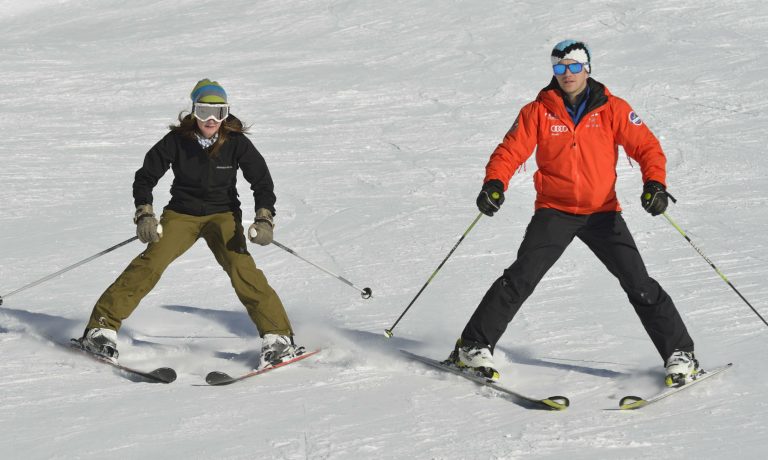Every journey begins with a single step. The journey of learning to ski begins with a single run. This article will provide you with a good idea of what to expect the learning process to look like when going into the pursuit of skiing. You can expect a very standard progression of skills that build upon each other in small increments. While certainly each student progresses at a somewhat different pace, with good coaching and snow conditions, you’ll get the hang of it before you know it. Below we’ll cover the first four levels of skiing, which depending on the individual, can take anywhere from a few weekends to just a single afternoon. Remember, it is totally okay to spend the whole first day mastering level 1, and while an athletic 10-year old may be able to get to level 4 on his first day, safety and fun while learning at the pace that’s best for you is what really matters.
Level 1- first-time ever, no previous experience
In order to learn skiing, you must first be educated on the proper use of the equipment. This includes learning how to properly fit your boot on your foot, understand the different functions of the ski, and bring gloves, goggles etc. Your instructor starts you with one-footed ski drills. Stepping side-to-side, forward-and-backward, making snow angels while keeping your ski flat to the ground, and gliding with the foot not attached to a ski up for several seconds. Then you can put on both skis and get used to doing them with two skis on at once. Next, before going down the hill, you must first learn how to walk on the flat ground and up small hills through two methods, known as side stepping and herringbone. Now it’s time to get skiing! For your first attempted run, you will use the skills you just learned on walking up the hill, to go down a small five foot vertical straight run, in which you will naturally stop on the flat ground. This makes you learn the proper athletic stance to balance and get you used to going down the hill in a safe, controlled setting. What do you need next? To be able to stop yourself. Here, your coach will teach you how to turn your skis into a wedge, also commonly referred to as a pizza, by rotating legs inward and pushing out on the heels. Once learned, you practice a gliding wedge down a small hill where you gradually come to a stop on the flat ground thanks to your wedge. Finally, you learn the necessary skill of getting up after falling, which is much easier than it looks, but once learned, a piece of cake.

Level 2 - can safely stop on beginner green circle terrain.
Time to apply everything you’ve learned in level 1. Like previously stated, it's all about gradual incremental steps for learning. So you jump from a gliding wedge to a breaking wedge. The difference is that for the breaking wedge, you have more speed, apply a wider wedge in order to stop while still on a downhill slope. Essentially, you learn to stop going slightly faster in a quicker motion. This can be a hard step to take since you must trust the skills learned more than before for a more forceful action.
Level 3 - can make wedge turns in both directions on beginner terrain.
A truly thrilling jump forward into your ski journey: turning. Turning is a whole progression in itself. So you start with the basics. You take the wedge you just learned and use it to learn turns. Coaches tend to turn the beginning of turns slightly different, but there are many different progressions and they all work. Typically, you start the process by starting your downward run already pointed across the hill, and just to one side in the beginning. You will learn the importance of rotating your skis and applying your weight on your downhill ski. Once comfortable making the single wedge turn, you learn to link the turns back and forth down the hill. Again, this step takes a level of trust and commitment to the rotation of your skis and shift of your weight facing down the hill. Learning the linked wedge tearns is a stellar accomplishment, and at this point nothing will slow your pursuit of excellence down.
Level 4 - can link turns with moderate speed on all beginner terrain.

The next progression in turns goes by the name of wedge christie. A wedge christie differs from a wedge turn because your skis face parallel while traversing across the hill, form a wedge with initiating the downhill shift to the other side, then returning parallel while traversing, until your next wedge. The key to the progression of learning skiing fundamentals is that each step is small and builds your confidence to keep moving forward. This list is just an introduction to the beginning levels of the learning process. Everyone cruises through it at different paces and some people excel in some skills, while other skills can take longer. Sometimes it’s just doing it right and capturing the feeling of how to do it, or a coaches’ phrasing of how to do it that can get you to keep moving forward. Each time you accomplish a skill it will keep your desire to keep learning burning. And of course, expect tons of repetitions of the skill learned until moving forward. Every journey begins with a single step. This one begins with a single run.
Back to Blog


Follow Us
Follow us online, join our conversations, engage with our teams around the world!